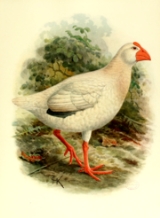
Lord Howe Swamphen
Encyclopedia
The Lord Howe Swamphen or White Gallinule, Porphyrio albus, was a large bird
in the family Rallidae
endemic to Lord Howe Island
, Australia
. It was similar to the Purple Swamphen
, but with shorter and more robust legs and toes. Its plumage was white, sometimes with a few blue feathers, and it was probably flightless, like its other close relative the Takahe
. Similar, entirely blue birds were also described, but it is not clear if they belong to this species or are simply Purple Swamphens (which can also be found on the island). The feathers on the two extant skins are white.
 This bird was first described by John White
This bird was first described by John White
in his Journal of a Voyage to New South Wales (1790), which also contained an illustration. It was not uncommon when the bird was first described, but was soon hunted to extinction by whalers and sailors.
There are two skins of the bird in existence, in the museums of Liverpool and Vienna. There are also several paintings, and some subfossil bones.
Bird
Birds are feathered, winged, bipedal, endothermic , egg-laying, vertebrate animals. Around 10,000 living species and 188 families makes them the most speciose class of tetrapod vertebrates. They inhabit ecosystems across the globe, from the Arctic to the Antarctic. Extant birds range in size from...
in the family Rallidae
Rallidae
The rails, or Rallidae, are a large cosmopolitan family of small to medium-sized birds. The family exhibits considerable diversity and the family also includes the crakes, coots, and gallinules...
endemic to Lord Howe Island
Lord Howe Island
Lord Howe Island is an irregularly crescent-shaped volcanic remnant in the Tasman Sea between Australia and New Zealand, directly east of mainland Port Macquarie, and about from Norfolk Island. The island is about 11 km long and between 2.8 km and 0.6 km wide with an area of...
, Australia
Australia
Australia , officially the Commonwealth of Australia, is a country in the Southern Hemisphere comprising the mainland of the Australian continent, the island of Tasmania, and numerous smaller islands in the Indian and Pacific Oceans. It is the world's sixth-largest country by total area...
. It was similar to the Purple Swamphen
Purple Swamphen
The Purple Swamphen , also known as the African Purple Swamphen, Purple Moorhen, Purple Gallinule, Pūkeko or Purple Coot, is a large bird in the family Rallidae . From its name in French, talève sultane, it is also known as the Sultana Bird...
, but with shorter and more robust legs and toes. Its plumage was white, sometimes with a few blue feathers, and it was probably flightless, like its other close relative the Takahe
Takahe
The Takahē or South Island Takahē, Porphyrio hochstetteri is a flightless bird indigenous to New Zealand and belonging to the rail family. It was thought to be extinct after the last four known specimens were taken in 1898...
. Similar, entirely blue birds were also described, but it is not clear if they belong to this species or are simply Purple Swamphens (which can also be found on the island). The feathers on the two extant skins are white.

John White (surgeon)
John White was an English surgeon and botanical collector.White was born in Sussex and entered the Royal Navy on 26 June 1778 as third surgeon's mate. He was promoted surgeon in 1780, and was the principal surgeon during the voyage of the First Fleet to Australia...
in his Journal of a Voyage to New South Wales (1790), which also contained an illustration. It was not uncommon when the bird was first described, but was soon hunted to extinction by whalers and sailors.
There are two skins of the bird in existence, in the museums of Liverpool and Vienna. There are also several paintings, and some subfossil bones.

